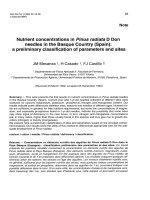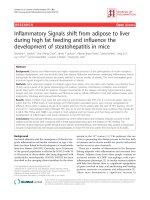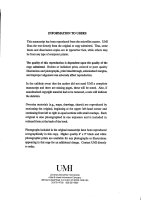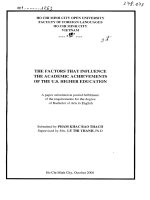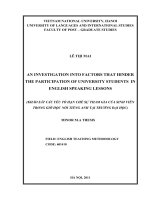Factors that Influence Successful Start-Up of Home Visiting Sites pptx
Bạn đang xem bản rút gọn của tài liệu. Xem và tải ngay bản đầy đủ của tài liệu tại đây (376.37 KB, 36 trang )
Factors that Influence
Successful Start-Up of
Home Visiting Sites
Lessons Learned from Replicating
the First Born® Program
M. REBECCA KILBURN AND JILL S. CANNON
WR-884
October 2011
This paper series made possible by the NIA funded RAND Center for the Study
of Aging (P30AG012815) and the NICHD funded RAND Population Research
Center (R24HD050906).
WORKING
P A P E R
This product is part of the RAND
Labor and Population working
paper series. RAND working papers
are intended to share researchers’
latest findings and to solicit informal
peer review. They have been approved
for circulation by RAND Labor and
Population but have not been
formally edited or peer reviewed.
Unless otherwise indicated, working
papers can be quoted and cited
without permission of the author,
provided the source is clearly referred
to as a working paper. RAND’s
publications do not necessarily
reflect the opinions of its research
clients and sponsors.
is a registered trademark.
Factors that Influence Successful Start-Up of Home Visiting Sites:
Lessons Learned from Replicating the First Born® Program
Abstract
Growth in federal, state and private funding is fueling the initiation of home visiting programs
around the country. As communities expand home visiting programs, they need information
about how they can successfully start up new sites. This paper proposes measures of successful
home visiting program implementation and identifies factors that promote successful
implementation or serve as barriers to program initiation. We focus on lessons learned from the
replication of the First Born® Program in six counties in New Mexico. Specifically, we examine
how well sites met staffing, family referral and enrollment, program fidelity, and financing goals
in the first year of providing services. Data come from semi-structured interviews with senior
program staff and program documentation. The findings are likely to be valuable to a wide
spectrum of communities starting or expanding home visiting services, as well as to public and
private funders of programs.
Key Words: home visiting, implementation, early childhood, prevention, child and maternal
health
Author Contact Information
M. Rebecca Kilburn, Ph.D. (corresponding author)
Senior Economist
RAND Corporation
1776 Main Street, P.O. Box 2138
Santa Monica, CA 90407
Phone: 310-393-0411 ext. 6454
Fax: 310-260-8176
Email:
Jill S. Cannon, Ph.D.
Policy Fellow
Public Policy Institute of California
500 Washington Street, Suite 600
San Francisco, CA 94111
Phone: 415-291-4411
Fax: 415-291-4401
Email:
We gratefully acknowledge these organizations for supporting this research: Con Alma Health
Foundation, The Pew Center on the States, the W.K. Kellogg Foundation, and the Smith
Richardson Foundation. We also would like to extend special thanks to the staff at the home
visiting sites and the many other individuals who participated in interviews and provided
documents reviewed for this paper.
SUCCESSFUL HOME VISITING START-UP
1
Introduction
A combination of new federal funding opportunities, philanthropic investments, and
mounting research evidence is spurring expansion of home visiting programs in communities
around the U.S. The health care reform bill, the Patient Protection and Affordable Care Act,
includes a total of $1.5 billion in new funding for home visiting, and every state is eligible to
receive a portion of those funds.
1
This first recurring federal commitment to home visiting
follows on the heels of a decade of expanded state investment in home visiting. It has been
estimated that in the 2009-2010 fiscal year, 46 states and the District of Columbia invested $1.37
billion in home visiting (Pew Charitable Trusts, 2011a, 2011b). Private funders have also
increased their investments in home visiting. Perhaps most notably, the Pew Charitable Trusts
launched a major home visiting initiative in 2008 as part of its Pew Center on the States.
Furthermore, as the concept of “evidence-based programs” gained traction among government
and private funders, home visiting has become recognized as a promising approach to preventing
poor outcomes in areas such as health, education and criminal justice by groups ranging from the
American Academy of Pediatrics (2009) to the Coalition for Evidence-Based Policy
(
This paper proposes measures of successful home visiting program implementation and
identifies factors that promote successful implementation. We share the lessons learned from
expanding the First Born® Program (FBP), a home visiting program for first-time parents in
New Mexico. Specifically, we summarize the factors that promoted successful replication of the
FBP and those that served as obstacles to timely or smooth initiation of the program. We focus
1
For the funding announcement, see
SUCCESSFUL HOME VISITING START-UP
2
on the replication sites’ ability to achieve staffing, referral and enrollment, and program fidelity
goals in the first year of service.
The information in this paper comes from document reviews and interviews with
program managers and other staff at seven FBP sites as well as interviews of funders, the FBP
developer, staff at area hospitals, and government officials over a four-year period during which
the FBP was expanding beyond its original site. Although the information we provide derives
from the experience in scaling up the FBP, the lessons learned are likely to be valuable to a wide
spectrum of communities who are implementing various home visiting models. The factors that
we discuss include community outreach, hiring staff, recruiting families, and other issues that are
common across all home visiting models.
The next section describes the context of the FBP, the communities that adopted the FBP,
and the policy environment. In the third section, we provide an overview of previous literature
on implementing social services generally and home visiting specifically. The fourth section
details the methods we used for collecting information and the sample of sites that provided
information. We present the findings regarding the factors that promoted or were barriers to
implementing the program in the fifth section. The final section offers some conclusions.
The Context of the First Born® Program
The First Born® Program began in Silver City, New Mexico in 1997, but the second site
did not begin operating until a decade later at the impetus of a private funder. Additional State
and private funding increased the number of FBP sites over several years. This section describes
the expansion of the FBP around the state of New Mexico between 2007 and 2010.
SUCCESSFUL HOME VISITING START-UP
3
The Policy Environment
In 2006, about a dozen home visiting programs operated around the state of New Mexico,
and they included a range of program models, funding streams, and targeting strategies. There
were services provided to children diagnosed with disabilities in the federal IDEA Part C Early
Intervention program, a State-run case-management program for at-risk families, privately
supported programs operated by local United Way agencies, and others that had patched together
funding from a variety of government and private sources. However, at that time, the State did
not commit recurring funding to a designated home visiting system.
Meanwhile, across the U.S., a quiet surge in home visiting programs was underway. By
2009, a survey of states reported that 40 of 46 states responding to the survey offered state-based
home visiting services (Johnson, 2009). Additionally, the Pew Charitable Trusts had launched
the Pew Home Visiting Campaign, which included increasing federal and state support for
voluntary home visiting as a major goal. Meanwhile, the Nurse-Family Partnership (NFP) home
visiting model had grown from two replication sites in 1996 to sites across 31 states in 2010, as
well as a National Service Office that supported over 10 million dollars’ worth of activity in the
fiscal year ending September 2009.
2
The recent increase in interest in home visiting programs has been attributed to the strong
findings from a set of rigorous research studies conducted for the NFP (Gomby, 2005). Indeed,
NFP has conducted three separate clinical trials using randomized control designs and
consistently found improvements in child and maternal outcomes through the time the child was
15 years old (Olds et al., 1997; Olds et al., 1998; Olds et al., 2007). The statistically significant
2
Nurse-Family Partnership, 2010,
SUCCESSFUL HOME VISITING START-UP
4
improvements over these first 15 years ranged from mothers being more likely to breastfeed to
less likely to receive public assistance, and from children being less likely to visit the emergency
room to having fewer sexual partners as adolescents. Furthermore, the effects were often
sizable. For instance, when the children were between two and four years old, the nurse-visited
children had 40 percent fewer notations of injuries and ingestions and 45 percent fewer notations
of child behavioral and parental coping problems in physicians’ records (Olds et al., 1994), and
mothers in the program received public assistance for 30 fewer months compared to comparison
mothers (Olds et al., 1997).
The growing evidence related to the NFP coincided with another trend in social
programs: the evidence-based policy movement. Organizations such as the Coalition for
Evidence-Based Policy advocated that the government favor social interventions that
demonstrated effectiveness through randomized trial evaluations,
3
and the Nurse-Family
Partnership was the only early childhood program to earn the Coalition’s “Top Tier” designation.
Late in 2010, the U.S. Department of Health and Human Services released a list of seven home
visiting models that they classified as “evidence-based” (Paulsell et al., 2010), and they have
subsequently listed other programs that meet the standards used in this review.
At the same time, the Los Alamos National Laboratory (LANL) Foundation began to
systematically review ways that they could help improve outcomes in their New Mexico focus
area. The LANL Foundation is a private foundation committed to improving Northern New
Mexico communities by investing in education, learning, and community development, and the
Foundation is supported largely by LANL and its employees. The Foundation’s strategic review
3
See www.evidencebasedprograms.org for further information.
SUCCESSFUL HOME VISITING START-UP
5
led them to focus on early childhood, and they decided that for the particular challenges facing
the largely rural, poor counties in the area, home visiting had shown the most promise for
improving child and maternal outcomes. They found convincing evidence for the effectiveness
of the NFP and strong support for replication from the National Service Office, but for other
leading models such as Healthy Families America, the research evidence was mixed or lacked
replication infrastructure.
After gathering more information about the Nurse-Family Partnership, the Foundation
decided that they were not able to implement this home visiting model. The NFP home visitors
are registered nurses (RNs), and the Foundation determined that it would not be able to hire
enough nurses in its Northern New Mexico service area, and in fact, this region and most of the
state of New Mexico is designated as a Health Professional Shortage Area by the Health
Resources and Services Administration.
4
Notably, most analysts report that nationally there is a
current shortage of nurses that is only expected to worsen in the coming decade (Buerhaus et al.,
2009, Heath Resources and Services Administration, 2006). Furthermore, the projected per
family total costs of NFP are sizeable—the NFP website reports average costs of $4500 per year,
and families participate in the program from the first trimester of pregnancy until the child’s
second birthday.
5
Why the First Born® Program?
Ironically, the LANL Foundation’s national search for an appropriate home visiting
program for Northern New Mexico took them to the southern part of their own state. They chose
4
See for information about Health Professional Shortage Areas.
5
See www.nursefamilypartnership.org for further information about NFP, and
www.nursefamilypartnership.org/assets/PDF/Fact-sheets/NFP_Benefits-Cost for cost information.
SUCCESSFUL HOME VISITING START-UP
6
to implement the FBP, which had been operating in Silver City for a decade, for several reasons:
a technical assistance and training infrastructure, which would facilitate replication; use of a
combination of nurse and non-nurse professionals; and costs that were about two-thirds of NFP
costs. Furthermore, an evaluation of the original FBP site, published in a peer-reviewed journal,
found that the program was meeting its stated objectives to promote family resiliency across
several domains (de la Rosa et al., 2005). The LANL Foundation focused initially on
implementing FBP programs in Rio Arriba County and Taos County in Northern New Mexico,
and both programs began serving children in 2007.
In 2008, the State of New Mexico began its first recurring funding stream to establish and
support a state system of home visiting. As of 2009, the State supported 14 organizations that
provided home visiting services in 19 of the state’s 59 counties. By 2010, five State-supported
FBP sites were operating in these counties: Grant (Silver City), Los Alamos, Rio Arriba, Santa
Fe, and Socorro. Additionally, a private non-profit health-promotion organization, St. Joseph
Community Health, began funding and delivering the FBP in the metropolitan Albuquerque area
in 2010. However, Taos County had abandoned the FBP model in 2009 in favor of their
homegrown “First Steps” home visiting model, and they continued to receive state funding for
this model.
All of these sites reported selecting the FBP for reasons similar to those cited by the
LANL Foundation:
• Their organization’s goal was to improve the types of child and maternal health that
home visiting has shown promise in improving relative to other service strategies.
SUCCESSFUL HOME VISITING START-UP
7
• They recognized the evidence base for the NFP program, but they thought NFP was
impractical for their community due to nursing shortages, perceived high cost of NFP,
and the fact that they did not have enough births to meet the NFP’s requirement of 100
high-risk parents in order to establish a site.
6
• They valued the existence of FBP technical assistance and training to replicate the
program in their communities, along with a written curriculum with materials that FBP
provided.
Two published articles about the program showed that the program was achieving its
intermediate family-functioning goals for participants (de la Rosa et al., 2005; de la Rosa et al.,
2009).
The First Born® Program Model
FBP participants, who are generally mothers, can enroll during pregnancy up through the
child’s second month, and the program ends when the child reaches age three. Services are free
and are offered to all first-time families. Trained home visitors deliver the program, typically in
the child’s home, using the trademarked FBP, which adapts previous home visiting models to a
community-wide setting, including rural settings. Home visitors generally have greater than a
high school education, some human services experience, and have met the competencies required
as part of FBP training, as well as “shadowing” existing FBP home visitors. The home visitors
work closely with local health care providers, hospitals, and social service agencies to identify
and recruit first-time parents and facilitate access to preventive and developmental services. The
FBP team includes a registered nurse, who provides a postpartum home visit offered to the
6
See ies for site
requirements.
SUCCESSFUL HOME VISITING START-UP
8
parents of all participating newborns and continues to participate in the home visits when
families encounter medical challenges. The FBP model calls for at least 40 weekly home visits
in the child’s first year of life. Visits may be less frequent in the child’s second and third year of
life.
The FBP uses a three-pronged approach to promote child and family well-being:
• Family Education. Home visitors work with the family to develop life and social skills
such as decision-making, crisis intervention, and child developmental assessment and
knowledge.
• Problem Identification and Referral. Home visitors use screening tools to identify family
members who need referrals to other resources to address issues including substance
dependency, family violence, and developmental delays.
• Coordination of Community Resources. Program staff participates in community-based
councils, task forces, and other teams to ensure the effective coordination of data and
services.
As a result of the program, participating families are expected to enhance family
functioning and develop protective factors that will facilitate their positive development in the
short and long term. The FBP is guided by three theories—self-efficacy and empowerment,
family ecology, and attachment and bonding—that characterize behavioral change as dependent
on an individual’s beliefs, motivations, and emotions as well as the family’s community context.
Specifically, the program works to enhance family resiliency by promoting:
• Positive interaction between parent and child
• Positive parenting behaviors
SUCCESSFUL HOME VISITING START-UP
9
• Increased factual knowledge about pregnancy, delivery and child health
• Increased knowledge about the effects of alcohol, tobacco and other drugs
• Decreased risky behaviors on the part of the parents.
Ultimately, families are likely to experience better outcomes in the areas of physical and
mental health, social and family interactions, cognitive development, and family goal and
challenge management. The program helps families improve intermediate outcomes in the form
of family behaviors, knowledge, and interactions, which in turn promote the mother’s and child’s
physical and mental health and other outcomes such as improved education and absence of abuse
and neglect.
7
The FBP has participated in several types of evaluation. First, the FBP sites regularly
collect data for continuous quality improvement and ongoing process self-evaluation. Second,
the program has participated in two process evaluations. An evaluation of the original Silver
City program, which examined whether the site was meeting its stated objectives rather than
comparing the program to some alternative such as families not enrolled in the program,
presented promising results (de la Rosa et al., 2005). Specifically, families scored much higher
on measures of family resiliency, such as social support and family interaction, after
participating in the program. A second study (de la Rosa, 2009) assessed the effect of the
program on measures of participating families’ well-being and the relationship between more
home visits and family outcomes. This study found that after participating in the FBP, families’
scores significantly improved on measures of social support, positive family interaction and
caregiver characteristics, and families decreased the numbers of personal problems that would
7
For a more detailed description of the theory behind the FBP, see de la Rosa et al. (2005).
SUCCESSFUL HOME VISITING START-UP
10
affect parenting. Furthermore, the number of home visits was significantly related to improved
scores on these measures. Finally, a separate outcome evaluation under way by the authors of
this paper will examine the effects of the FBP on child and maternal outcomes through age 2
using a randomized field trial design.
Implementation Literature and Organizing Framework
We review some of the most relevant entries in the general literature on the
implementation of social services and then studies that focus on home visiting implementation.
We place the current study in the context of the broader literature and provide a framework for
assessing implementation factors for the FBP replication.
8
Social Service Implementation Research
As a whole, both the health care literature and social science literature lament the dearth
of research related to implementation (Rubinstein and Pugh, 2006; Fixsen et al., 2005).
Implementation research is often framed in the context of providing evidence-based or evidence-
informed services, where service providers are attempting to put research into practice. That is,
evaluations have demonstrated that a set of practices or a particular program can successfully
improve participants’ outcomes, but only when replicating organizations can implement the
intervention successfully. Implementation research provides information about how to
successfully replicate these evidence-based or evidence-informed interventions.
Much of the implementation literature focuses on specific components of
implementation, such as organizational factors that promote the successful adoption and
8
There is also a burgeoning literature on implementation in the health care sector, but we do not review that
literature here.
SUCCESSFUL HOME VISITING START-UP
11
execution of innovative strategies (e.g., Greenhalgh et al., 2004) or how to achieve successful
intervention fidelity (e.g., Carroll et al., 2007). We use concepts from the Fixsen et al. (2005)
synthesis of implementation research to place this paper in the context of the broader
implementation literature and to provide a framework for the assessment of the factors that
promoted the adoption of this particular intervention. We chose to draw on this reference
because it incorporates a comprehensive set of implementation factors rather than focusing on
one or a few; it is heavily referenced in the field; and a number of federal initiatives that are
highly influential for home visiting have provided training by Fixsen and colleagues or they have
referred to the publication in their requests for proposals or other instructions to grantees (e.g.,
SAMHSA’s Project LAUNCH grantees meeting and HRSA’s Maternal, Infant, and Early
Childhood Home Visiting webinar series).
9
Fixsen et al. (2005) describe implementation as a process that can be characterized by the
stages shown in Figure 1. This study assesses which factors facilitated and hindered
communities’ successful adoption and implementation of the FBP in the first three phases:
Exploration and Adoption, Program Installation, and Initial Implementation. Specifically, we
examine communities’ activities after they had made the decision to adopt the FBP and up to one
year after providing a home visit to their first client.
9
For further information, see and
/>.
SUCCESSFUL HOME VISITING START-UP
12
Reproduced from Fixsen et al. (2005), p. 15.
Figure 1: Stages of the Implementation Process
Fixsen and colleagues further describe a set of multilevel influences that affect
implementation. These influences include Core Implementation Components, Organizational
Components, and Influence Factors. Core Implementation Components are factors that are
related to successfully replicating a particular program model or curriculum with fidelity, and
these factors include: staff selection, staff training, ongoing coaching and monitoring of staff
activities and compliance with curricula, and evaluating organization-level delivery of the
intervention. Fixsen and colleagues describe the Core Implementation Components as operating
within the Organizational Components and that both of these also are subject to Influence
Factors. The Organizational Components are the administrative structures and processes that
facilitate effective delivery of the program model, and the organization-level components that
Exploration and Adoption
Program Installation
Initial Implementation
Full Operation
Innovation
Sustainability
We focus on
these stages.
SUCCESSFUL HOME VISITING START-UP
13
must be well executed range from personnel management to fundraising to community outreach.
The organizational level is also typically responsible for managing the impact of Influence
Factors on the successful implementation of the intervention. The Influence Factors that can
affect programs may vary over time and locations and may be manpower availability in one
community, funding levels in another, and high-visibility media coverage of catastrophic child
outcomes in yet another location.
Our examination of the factors that facilitated and hindered successful early
implementation of the FBP incorporates all three of these levels of influence. Our interview
protocols contained items that captured information about the functioning, context, resources,
and influences for the core components that were specific to delivering the FBP as well as the
organizational aspects and the external factors.
Home Visiting Program Implementation
Extant literature also provides information on implementing home visiting specifically.
These studies range from a focus on state-level factors that influenced implementation down to
site-level and even home-visitor level characteristics that were associated with various
implementation outcomes.
Starting from the broadest perspective, several papers present information about state-
level home visiting implementation. Wasserman (2006) reviews states’ approaches to
developing and sustaining state-based home visiting services. Wasserman discusses state
experiences selecting which home visiting model to implement, how the states secured ongoing
funding for home visiting, states’ evaluation programs, and states’ efforts to monitor program
fidelity.
SUCCESSFUL HOME VISITING START-UP
14
Most studies of home visiting implementation examine implementation at the community
level. Galano et al. (2004) describe the external influences that “set the stage” for a small city
government adopting the Healthy Families America model as part of a comprehensive
realignment of child and family services from a treatment paradigm to a prevention paradigm.
Ammerman et al. (2007) also examine the implementation of home visiting in a large area, but in
an urban metro area, and the organization that led the program development was a large research
hospital. Ammerman and colleagues describe the origins of the program, challenges that they
encountered throughout the process, and this program’s emphasis on data collection and
continuous quality improvement as the program matured. Another study, Hicks et al. (2008),
developed measures of the degree of community collaboration in the home visiting programs in
16 communities and tested whether these collaboration measures were related to the retention of
families in the home visiting program. They found that the community collaboration measures
explained a moderate amount of the variance in family retention.
Several studies have examined specific program factors in home visiting implementation.
In their study of Hawai’i’s Healthy Start Program, Duggan et al. (2000) assess a number of
process outcomes for a home visiting program for at-risk families with newborns to provide
information about the ability of programs to identify and engage families. They found that early
identification specialists could successfully execute population level screening to identify
targeted families 84 percent of the time, and half of the families that enrolled were still
participating at the end of the year. Those still enrolled after a year had received an average of
22 visits.
SUCCESSFUL HOME VISITING START-UP
15
Daro et al. (2003) examine which program level factors are associated with better family
retention and a greater number of visits in a Healthy Families America site. Programs with
lower caseloads and that had better matches between mothers and home visitors on race and
parenting status had better results. Also at the program level, Culp et al. (2004) used the number
of visits and curriculum content of visits as measures of program fidelity to document high levels
of fidelity in a home visiting program implemented in five counties by a state health department.
Finally, some studies focused on implementation at the home visitor level or family level.
For instance, Kitzman et al. (1997) documented common challenges that nurse home visitors
encountered and how they overcame those challenges within the program specifications.
Similarly, LeCroy and Whitaker (2005) document the most difficult situations encountered by 91
Healthy Families home visitors in order to inform training for home visitors. McGuigan et al.
(2003) and Daro et al. (2003) investigate which family characteristics are associated with
program retention. McGuigan et al. (2003) find that older mothers and Hispanic mothers are
more likely to remain in a home visiting program. Daro et al. (2003) also find that the only
provider characteristic that predicted both greater retention and number of visits was age, with
younger home visitors having better outcomes. They also report that a number of maternal
characteristics were positively associated with retention and number of visits including enrolling
earlier in pregnancy, being unemployed or in school, and being older and African-American or
Hispanic. Additionally, McFarlane et al. (2010) examine how home visitors’ and mothers’
attachment styles (e.g., trust) affect family engagement in the program and associated outcomes.
The research reported in this paper adds to this literature by documenting factors that
promoted the successful first-year implementation of the same home visiting program model
SUCCESSFUL HOME VISITING START-UP
16
across multiple community sites within the same state. Hence, the program model core
components and the state external influences were being held constant, and the community and
site-level factors varied in our setting.
Methods
Measures
A vast literature exists on the implementation of social services and a small but growing
literature on home visiting implementation, but there currently do not exist widely-used or
standardized measures for assessing levels of implementation. We draw on the leading synthesis
of implementation research (Fixsen et al., 2005) and a small set of studies that have proposed
implementation measures or conducted similar analyses to guide the measures that we employ
here (Proctor, et al., 2010; Quint et al., 2011) .
Our examination of the factors that facilitated and hindered successful early
implementation of the FBP incorporates all three levels of influence described by Fixsen et al.
(2005): Core Implementation Components, Organizational Components, and Influence Factors.
Our interview protocols contained items that captured information about the functioning,
context, resources, and influences for the core components that were specific to delivering the
FBP as well as the organizational aspects and the external factors.
Given that the objective of this study is to identify factors that promoted or inhibited
successful site start-up, it is important to be specific about the way “success” is defined in this
context. Rather than successful start-up being expressed as one binary variable, in this case it is
better characterized by success in achieving a number of outcomes (as in the Quint et al. [2011]
SUCCESSFUL HOME VISITING START-UP
17
study of scaling up a college completion program). We consider four measures of successful site
start-up, and these are similar to the “implementation outcomes” proposed by Proctor et al.
(2010).
One way to define successful start-up is in the financial realm—that is, whether sites
were able to operate programs without running a deficit. All of the sites that we interviewed
were able to successfully operate within their budgets during the first year with one exception,
and this site had only a small budget deficit. Because there is no variation in this outcome, we
are not able to relate successful financial operation to site-specific factors. Thus we do not report
further on this measure.
A second way to define success in this start-up phase is the degree to which a site was
able to hire, train, and retain staff according to plan within the first year. A third success
measure is whether a site met its family referral and enrollment targets. Although this measure
might seem to be the least subjective and more quantitative of the measures we have enumerated,
it is in fact not obvious how this should be measured. FBP is intended to be a “universal”
program, but not every family that is offered the program will enroll, and so there is some
uncertainty about whether serving “all” families in an area implies enrolling half of families, 80
percent of families, or some other percentage. In addition, some sites only had enough funding
to serve a portion of eligible families, and therefore these sites might reach full capacity while
only serving a small fraction of eligible families in their area. Due to these considerations, we
used the site’s target enrollment that they articulated prior to commencing home visiting as the
standard that constituted successful referral and service numbers. This target number was often
required to be stated as part of funding applications.
SUCCESSFUL HOME VISITING START-UP
18
A final measure of successful site start-up is the degree to which the site was able to
deliver services with fidelity to the FBP model. We assessed this using reports from the sites
about their activities and compared these to the guidance in the FBP fidelity, curriculum and
other manuals (e.g., First Born® Program, 2009) and also to information provided by the
program developer.
An additional measurement issue that needs to be explicit is the frequency with which we
needed to observe the presence of a factor across sites in order to consider that factor a
contributor to the successful start-up or an obstacle to successful start-up. We consider a factor
to be supported as a contributor to a first-year start-up outcome if it was present in more than half
of the sites that successfully achieved that start-up outcome and was not present in any sites that
did not achieve that outcome.
Study Sample
We include six sites that chose to start the FBP in their communities between 2007 and
2010. Of these six sites, four are primarily rural, one is a small city, and one is in a larger city.
One site stopped implementing the program after the first year. One is a very new start-up,
beginning home visits in mid-2010, while two began the program in 2007, and the other sites
began in between. Five of the sites are in counties with one primary hospital serving families,
while one site is in a multi-hospital setting. Only one of the six sites had a strong home visiting
presence in the community prior to implementing the FBP. The number of families served by
these sites in the first year ranged from about 30 to 100. Note that we interviewed the original
FBP site in Silver City, but we do not analyze their initial implementation, which occurred over a
decade ago.
SUCCESSFUL HOME VISITING START-UP
19
Data Collection and Analysis Methods
The primary sources of data for this study are document reviews and in-person interviews
conducted between July 2007 and July 2010 with senior program staff at each site, ranging from
one to three persons per interview. We also followed up by phone with two sites in 2011 to
ensure information was collected through the first year of implementation. At a minimum, we
interviewed the program manager at each site, but for several sites we also included home
visitors in interviews, and some sites included representatives of the hosting organization of the
program (e.g., hospital, health agency). We used a common semi-structured, open-ended
interview protocol to elicit opinions of site experiences as they started the program and staff
perceptions of successes and obstacles to early implementation. We also asked specifically what
lessons they learned that they would want to share with other sites starting up in the future.
10
Each interview began with opening statements by the interviewers about the purpose of the
interview and the confidentiality of responses, and respondents provided verbal consent to
proceed with the interview.
11
We created an interview instrument with a set of questions to ask
of each site, but we also allowed conversations to address other topics respondents wished to
discuss. We interviewed each site at least twice to gather information for this study.
Two interviewers participated in each site interview, and both took handwritten notes.
One interviewer had primary responsibility for note taking and typed up the field notes, which
were then reviewed by the second interviewer for completeness and accuracy. Any differences in
notes were discussed and final notes agreed upon by both interviewers.
10
One limitation of this approach is that it elicits indirect information about the program and not all persons are
equally articulate or perceptive (Creswell, 2003). However, we used probing questions as necessary to try to elicit
equally detailed information across sites.
11
The authors’ institutional Human Subjects Protection Committee reviewed and approved the consent process and
site visits and interviews.
SUCCESSFUL HOME VISITING START-UP
20
We read through the final interview notes to first get a general sense of respondent
perspectives and tone. Then we classified comments into several themes and categories within
themes and noted when more than one site stated similar perspectives. In general, both
researchers identified similar themes. We interviewed each site at least once after they had begun
visiting families and within one year of start-up, but some had several more months of
implementation experience than others. Thus, this study focuses on the sites’ pre-implementation
and early implementation experiences through the first year of serving families.
In addition to interviews, we also gathered site records such as quarterly or annual reports
prepared for funders and basic site statistics. We also reviewed FBP documents and manuals,
such as the First Born® Program Replication Guide (First Born® Program, 2009). One of the
researchers is also a resident of New Mexico and regularly attended the FBP Evaluation Steering
Committee meetings between summer 2006 and summer 2011. The researcher has also had
periodic meetings and conversations with New Mexico state agency staff and communities about
home visiting and other early childhood programs. These additional sources of information help
serve as a validity check on the interview information. Furthermore, the study conclusions were
shared with the interview respondents to ensure they felt the information stated by the
researchers was accurate. Both researchers are currently conducting an outcome evaluation of
one of the FBP sites in this study.
In terms of the stages of the implementation process as outlined in Fixsen et al. (2005),
the study period corresponds to the period after the site has decided to adopt the FBP through
program installation and initial implementation. This includes varying numbers of months of
community outreach, hiring and training staff, serving families and other activities.
SUCCESSFUL HOME VISITING START-UP
21
Results
We describe here the factors that are either contributors or obstacles to the successful first
year start-up, organized by the three start-up outcomes that varied across sites. All of the sites
were able to operate within their first-year budget, so we do not analyze factors that contributed
to this successful financial outcome for the sites.
Staffing
The sites’ abilities to meet first-year hiring and training goals varied by position—that is,
the FPB experience on this outcome was different for the home visitor, nurse, and program
manager positions. All sites were able to hire and train home visitors according to plan, and the
sites were generally able to retain the majority of home visitors. At most sites, enrollments grew
over the first year rather than enrollments starting at a steady rate as soon as services were
offered. As a result, it may be preferable to add home visitors as a site’s enrollment grows rather
than hiring upfront the entire expected number of home visitors needed at full capacity. The
noted tradeoff to this approach is the need to stagger staff training as new home visitors are
hired, and that may be less efficient. But one risk of hiring the entire staff at the outset is having
more home visitors than are needed for enrollments, which can lead to overstaffing for many
months and the need to keep staff engaged in other ways.
Home visitors are not the only staff involved in the FBP, however, and there were some
challenges in staffing the other positions. The FBP model includes a registered nurse at each
site, and this nurse conducts a post-partum home visit for each family, undertakes a file review
periodically with each family’s home visitor to identify instances where medical intervention or
screening might be warranted, and teams with other home visitors when any medical issues arise.
SUCCESSFUL HOME VISITING START-UP
22
Given the interpersonal nature of home visiting, the FBP highly recommends that nurses be
bilingual so that the nurse can communicate directly with the majority of families, who would
speak either English or Spanish. Several sites had difficulty hiring or retaining nurses in the
program because of a general community shortage of nurses, FBP pay scales that were lower
than hospital pay scales, or lack of bilingual skills. Thus these sites adopted different approaches
to hiring for this position to ensure at a minimum that a nurse or other certified health
professional could perform the postpartum visits to assess medical issues. Sites used different
methods depending on community factors, including hiring a licensed nurse practitioner (LPN)
or certified doula in lieu of a registered nurse, contracting with a non-FBP nurse to perform
postpartum visits as needed, or including a bilingual home visitor on nurse visits with Spanish-
speaking families. While this approach to mitigating this staffing challenge has been received
positively by the site and the FBP developer, it is noteworthy that hiring a nurse, and especially a
bilingual nurse, may be a challenge for future sites.
Another position for which some sites experienced obstacles was the program manager
position. All the people we interviewed stressed the fact that this position was of paramount
importance for a site’s success, and that achieving excellence in this position was critical.
Indeed, the responsibilities of the program manager are numerous, span a wide range of skills,
and involve difficult and sensitive tasks, such as close supervision of staff, meeting financial
goals during tough economic times, and delivering regular and sometimes lengthy reports to
various funders and the program developer. Many program managers reported high levels of
stress and burnout, and this resulted in manager resignations in some instances. While this rate
of leadership turnover may not be unusual for human services providers, it is certainly an area
where new sites should give extra attention.
SUCCESSFUL HOME VISITING START-UP
23
Program managers suggested a number of ways to reduce the burden and provide support
for this very challenging position. They reported that having regular meetings between managers
was very helpful, because it facilitated peer-to-peer information sharing, and also provided an
informal support network of individuals facing many of the same challenges. It may be
beneficial in these types of peer networks to stratify program mangers according to experience,
because more experienced managers found these meetings to be a drain for them personally,
because they felt they only provided assistance to others at these meetings and did not get much
value in return. Program managers also stressed that having regular and frequent access to the
program developer was a boon to new program managers, because the program developer could
answer questions and acted as a “cheerleader” and supporter when challenges arose. Moreover,
administrative assistance in the office, whether paid or volunteer staff, can facilitate the
manager’s work and help manage the workload.
Family Referrals and Enrollments
Four of the six sites met or exceeded both their family referral and enrollment objectives
by the end of the first year of providing services. One of the key factors that many sites reported
they believe can promote success on this outcome is implementing what the FBP refers to as the
“preimplementation phase” for at least six months (First Born® Program, 2009), especially for
sites without a community history of home visiting. This phase typically takes place before
services are offered to families and emphasizes relationship building with community
organizations and outreach activities to promote the program and corresponds to the “Program
Installation” stage in Figure 1. The program’s fidelity manual emphasizes engaging the local
medical community, but it is also expected that the site will engage other community



